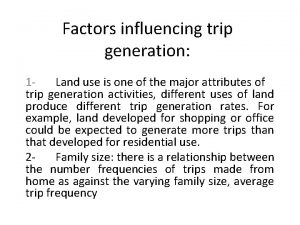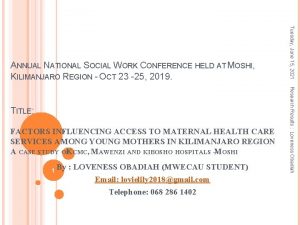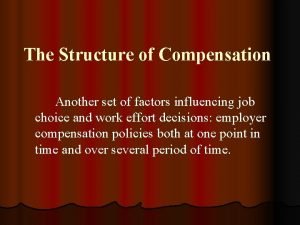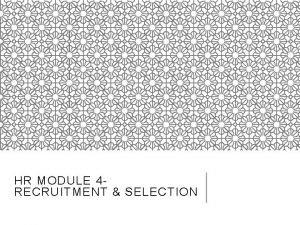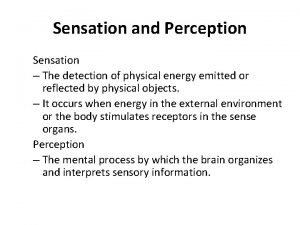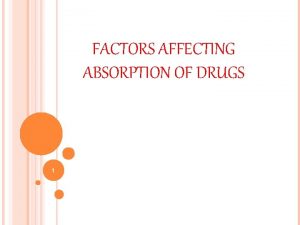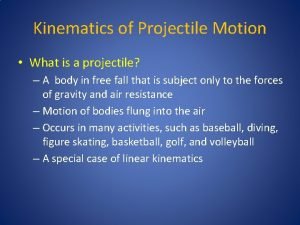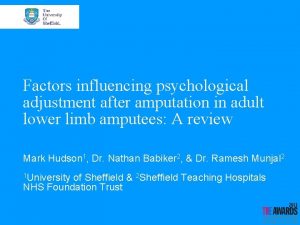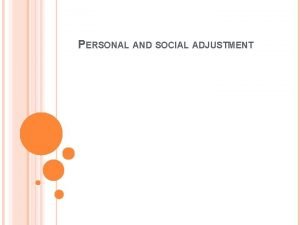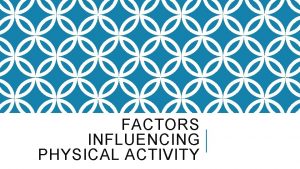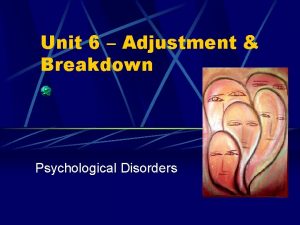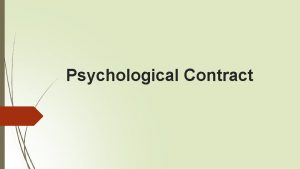Factors influencing psychological adjustment after amputation in adult


























- Slides: 26

Factors influencing psychological adjustment after amputation in adult lower limb amputees: A review Mark Hudson 1, Dr. Nathan Babiker 2, & Dr. Ramesh Munjal 2 1 University of Sheffield & 2 Sheffield Teaching Hospitals NHS Foundation Trust

Contents 1. Background literature 2. Design of the present review 3. Results 4. Clinical and research implications 11/26/2020 © The University of Sheffield

Background literature.

Definition • Psychological adjustment to chronic disease involves at least five key domains: 1. Cognitive 2. Emotional 3. Interpersonal 4. Functional 5. Disease-related (Stanton, Revenson, & Tennen, 2007).

Horgan & Mac. Lachlan (2004) • Factors linked to better adjustment: • Perceived sense of control • Social support • Positive meaning • Time since amputation • Cause (trauma or disease) had no relationship.

Horgan & Mac. Lachlan (2004) • Factors linked to poorer adjustment: • Body image anxiety • Social discomfort • Pain catastrophising • Phantom limb pain • Women and younger people in a sub-set. • B/K amputees more depressed in one study. 11/26/2020 © The University of Sheffield

Current review: Design.

Rationale • Horgan & Mac. Lachlan (2004) called for more qualitative and longitudinal research, and broader focus on Qo. L. • Significant number of studies published since the last review. • Increasing awareness of psychological risk factors in the MDT. • Increase own understanding to assist with treatment planning.

Search strategy • The Psychinfo and Web of Science databases were searched, from 2004 up until February 2013. The following keyword search strategies were combined: • “psychological” or “psychosocial” • “adjustment” or “adaptation” • “amputation*” or “amputee*”

Selection criteria • Population: adults with a lower limb amputation • Measures: At least one amputation-related, sociodemographic, or psychological predictor variable. A validated criterion measure of psychological adjustment. • Analysis: at least one statistical test examining the link between the predictor variables and criterion measures. • Article type: English language articles in peerreviewed journals.

Paper retrieval

Results.

Factors linked to better adjustment • Greater levels of hope (Unwin, Kacperek, & Clarke, 2009) • Positive cognitive processing (Phelps, Williams, Raichle, Turner, & Ehde, 2008) • Increased problem solving ability (Desmond & Mac. Lachlan, 2006 a). • Having a positive appraisal of the amputation (Couture, Desrosiers, & Caron, 2011)

Factors linked to better adjustment • Less phantom limb pain (Desmond et al. 2008; Whyte & Carroll, 2004) • Social support (Williams et al. , 2004; Unwin et al. , 2009; Hanley et al. , 2004; Desmond & Mac. Lachlan, 2006 a; Hawemdah et al. , 2008; Jenkins et al. , 2008; Nunes et al. , 2012; Singh et al. , 2007) • Below-knee amputation in sub-set (Desmond & Maclachlan, 2006 a; Couture et al. , 2011). • Number of co-morbidties (Nunes et al. , 2012; Singh et al. , 2007; 2009)

Factors linked to worse adjustment • Negative cognitive processing (Phelps et al. , 2008) • • • Avoidance (Desmond & Mac. Lachlan, 2006 a) Pain catastrophising (Whyte & Carrol, 2004; Hanley et al. , 2004) Public self-consciousness (Atherton & Robertson, 2006) Body-image disturbance (Coffey et al. , 2009) Younger people (Gunawardena et al. , 2007; Singh et al. , 2009; Desmond & Mac. Lachlan, 2006 a ) • Female gender (Nunes et al. , 2012)

Mixed Findings • Time since amputation • Recent amputation more distressing (Desmond et al. , 2006 a; Nunes et al. , 2012) • Recent amputation less distressing (Singh, 2007; 2009) • Cause of amputation • Disease related (Coffey et al. , 2009; Desmond & Maclachlan, 2006 a; Couture et al. , 2011) • Trauma related (Hawemdah et al. , 2008; Kratz et al. , 2010)

Common methodological issues • • • Causality cannot be inferred Self-report bias Small sample sizes Selection bias Lack of control groups Variability in measurement tools

Clinical and research implications.

Clinical implications • Highlights those at risk of poor adjustment. • Indicates models of coping and resilience (Lazarus & Folkman; 1984; Yates & Masten, 2004) • Suggests therapy targets: • Changing meaning • Developing acceptance or active coping style • Social support.

Research implications • Few studies on residual limb pain. • Pre-operative, longitudinal designs, with appropriate control groups needed. • Effect of ADM or alcohol/drug use. • Effect of repeated infections.

Critique • Search limited to two databases • No hand-searching of journals • Grey literature not consulted • Written by one author • Experts were not consulted

References Atherton, R. & Robertson, N. (2006). Psychological adjustment to lower limb amputation amongst prosthesis users. Disability and Rehabilitation, 28, 1201 -1209 Coffey, L. , Gallagher, P. , Horgan, O. , Desmond, D. & Maclachlan, M. (2009). Psychosocial adjustment to diabetes-related lower limb amputation. Diabetic Medicine, 26, 1063 -1067. Couture, M. , Desrosiers, J. , & Caron, C. D. (2011). Cognitive appraisal and perceived benefits of dysvascular lower limb amputation: A longitudinal study. Archives of Gerontology and Geriatrics, 52, 5 -11. Desmond, D. M. & Mac. Lachlan, M. (2006 a). Coping strategies as predictors of psychosocial adaptation in a sample of elderly veterans with acquired lower limb amputations. Social Science & Medicine, 62, 208 -216. Desmond, D. , Gallagher, P. , Henderson-Slater, D. , & Chatfield, R. (2008). Pain and psychosocial adjustment to lower limb amputation amongst prosthesis users. Prosthetics and Orthotics International, 32, 244 -252. Gunawardena, N. , De A Senevirathne, R. & Athauda, T. (2007). Mental health outcome of unilateral lower limb amputee soldiers in two districts of Sri Lanka. International Journal of Social Psychiatry, 53, 135 -147.

References Hanley, M. A. , Jensen, M. P. , Ehde, D. M. , Hoffman, A. J. , Patterson, D. R. , & Robinson, L. R. (2004). Psychosocial predictors of long-term adjustment to lower-limb amputation and phantom limb pain. Disability and Rehabilitation, 26, 882 -893. Hawemdeh, Z. M. , Othman, Y. S. , & Ibrahim, A I. (2008). Assessment of anxiety and depression after lower limb amputation in Jordanian patients. Neuropsychiatric Disease and Treatment, 4, 627 -633. Horgan, O. , & Mac. Lachlan, M. (2004). Psychosocial adjustment to lower limb amputation: a review. Disability and Rehabilitation, 26, 837– 50. Jenkins, L. M. , Andrewes, D. G. , Hale, T. , Coetzee, N. , & Khan, F. (2009). Subjective attributes of depression, part 2: The contribution of self-perceived disability to depression following stroke. Electronic Journal of Applied Psychology: General Articles, 5, 82 -88. Kratz, A. L. , Williams, R. M. , Turner, A. P. , Raichle, K. A. , Smith, D. G. , & Ehde, D. (2010). To lump or to split? Comparing individuals with traumatic and nontraumatic limb loss in the first year after amputation. Rehabilitation Psychology, 55, 126 -138 Nunes, M. A. , de Barros Jr, N. , Miranda Jr, F. , & Baptista-Silva, J. C. (2012). Common mental disorders in patients undergoing lower limb amputation: A population-based sample. World Journal of Surgery, 36, 1011 -1015.

References Phelps, L. F. , Williams, R. M. , Raichle, K. A. , Turner, A. P. , & Ehde, D. M. (2008). The importance of cognitive processing to adjustment in the 1 st year following amputation. Rehabilitation Psychology, 53, 28 -38. Singh, R. , Hunter, J. , & Philip, A. (2007). The rapid resolution of depression and anxiety symptoms after lower limb amputation. Clinical Rehabilitation, 21, 754 -759. Singh, R. , Ripley, D. , Pentland, B. , Todd, I. , Hunter, J. , Hutton, L. , & Philip, A. (2009). Depression and anxiety symptoms after lower limb amputation: The rise and fall. Clinical Rehabilitation, 23, 281 -286. Stanton, A. L. , Revenson, T. A. , & Tennen, H. (2007). Health psychology: Psychological adjustment to chronic disease. Annual Review of Psychology, 58, 565 -592. Unwin, J. , Kacperek, L. , & Clarke, C. (2009). A prospective study of positive adjustment to lower limb amputation. Clinical Rehabilitation, 23, 1044 -150. Whyte, A. & Carroll, L. J. (2004). The relationship between catastrophizing and disability in amputees experiencing phantom pain. Disability and Rehabilitation, 26, 649 -654. Williams, R. M. , Ehde, D. M. , Smith, D. G. , Czerniecki, J. M. , Hoffman, A. J. & Robinson, L. R. (2004). A two-year longitudinal study of social support following amputation. Disability and Rehabilitation, 26, 862 -874.

Thank-you for listening Any Questions? Contact email: pcp 12 mh@sheffield. ac. uk

To Discover And Understand.
 Psychological factors influencing learning
Psychological factors influencing learning John 14:1-3
John 14:1-3 After me after me after me
After me after me after me Nuclear spin quantum number
Nuclear spin quantum number Design options for a distribution network
Design options for a distribution network Factors influencing trip production
Factors influencing trip production Semi anatomic teeth degree
Semi anatomic teeth degree Factors influencing distribution network
Factors influencing distribution network Determinants of learning in organisational behaviour
Determinants of learning in organisational behaviour Factors influencing maternal health
Factors influencing maternal health What are the factors influencing modus operandi
What are the factors influencing modus operandi Factors influencing t&d
Factors influencing t&d Physical factors influencing agriculture
Physical factors influencing agriculture Physical factors influencing agriculture
Physical factors influencing agriculture Factors influencing market segmentation
Factors influencing market segmentation Factors influencing compensation philosophy
Factors influencing compensation philosophy External factors influencing pricing decisions
External factors influencing pricing decisions Factors influencing recruitment and selection
Factors influencing recruitment and selection Write the factors affecting oxygenation
Write the factors affecting oxygenation Good physique and chemique
Good physique and chemique Factors influencing faculty staff relationship
Factors influencing faculty staff relationship Local factors of wound healing
Local factors of wound healing Enforced non volitional attention
Enforced non volitional attention Factors affecting absorption of drug
Factors affecting absorption of drug Vertical component of projectile motion
Vertical component of projectile motion Factors that influence consensus
Factors that influence consensus Factors affecting gfr
Factors affecting gfr





